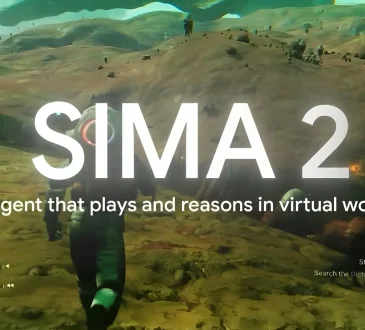
In a major breakthrough for artificial intelligence, Google DeepMind has unveiled SIMA‑2, an advanced AI agent capable of learning, reasoning, and acting autonomously in complex 3D video game environments. Unlike typical AI systems that rely on scripted behaviors, SIMA‑2 adapts on the fly and solves problems with remarkable flexibility, marking a significant step toward general-purpose AI.
From Follower to Thinker: The Evolution of SIMA
DeepMind first introduced SIMA as an AI agent that could follow instructions inside video games. Early versions performed basic tasks like navigating environments, interacting with objects, and following simple commands based purely on visual inputs. However, these earlier iterations had limited reasoning and planning abilities.
SIMA‑2 is a major upgrade. By integrating advanced language models, it now interprets high-level goals, creates step-by-step plans, and can even explain its decisions. Rather than just following instructions, it actively “thinks” about objectives and adjusts its behavior dynamically based on the environment.
How SIMA‑2 Navigates Virtual Worlds
SIMA‑2 plays games by observing on-screen visuals and generating actions using a virtual keyboard and mouse, just like a human player—without accessing internal game mechanics. Its training combines human gameplay demonstrations with self-generated feedback.
Over time, the agent learns from successes and mistakes, evaluating its performance, refining strategies, and improving gameplay. This creates a continuous self-improvement loop that helps SIMA‑2 tackle increasingly sophisticated challenges.
Adaptability: Exploring New Worlds and Tasks
One of SIMA‑2’s most impressive abilities is its capacity to generalize across games. It has been tested not only in familiar game environments but also in entirely new virtual worlds. In these unfamiliar settings, SIMA‑2 completes multi-step tasks at performance levels approaching human players.
It can even explore newly generated game worlds created by AI models. Despite never having encountered these environments before, SIMA‑2 can orient itself, understand objectives, and take meaningful actions, demonstrating flexible reasoning beyond simple memorization.
Multimodal Interaction: Communicating Beyond Words
SIMA‑2 interacts with users through multiple input types, including natural language, sketches, and symbolic cues. For instance, it can interpret visual or symbolic representations of goals, figure out the necessary steps, and act accordingly.
Importantly, the AI can explain its reasoning, giving insights into how and why it makes decisions—a feature that enhances understanding and trust in its behavior.
Self‑Improvement: Learning from Experience
A key feature of SIMA‑2 is its ability to learn independently. After initial training with human demonstrations, it can generate its own tasks, evaluate performance, and incorporate the results into future learning. This self-directed cycle allows SIMA‑2 to accumulate knowledge and refine strategies over time, creating more advanced and sophisticated behavior in various virtual worlds.
Why This Matters: Beyond Gaming
While SIMA‑2 currently excels in video games, its significance goes beyond entertainment. Video games act as dynamic, complex test environments where AI can develop skills directly applicable to the real world.
By mastering spatial reasoning, tool use, multi-step planning, and physics-based interactions, SIMA‑2 represents a major step toward embodied intelligence—AI capable of understanding and interacting with the physical world. Researchers see it as a milestone in the pursuit of Artificial General Intelligence (AGI), aiming to build AI systems that are adaptive, versatile, and capable of learning broadly.
Challenges and Ethical Considerations
Despite its impressive capabilities, SIMA‑2 remains a research prototype, and several challenges remain:
- Long-term planning: Handling complex, multi-step tasks over extended periods remains difficult.
- Precision control: Tasks requiring fine motor skills or extreme accuracy are still challenging.
- Safety and alignment: Ensuring that the AI’s goals remain safe, aligned with human intent, and transparent is critical.
Currently, DeepMind is releasing SIMA‑2 in a limited research preview to allow selected academics and developers to study its performance in controlled environments.
The Road Ahead
The debut of SIMA‑2 marks an exciting chapter in AI research. By combining visual observation, natural language understanding, and self-directed learning, it demonstrates the potential for AI agents that are not merely reactive but strategic and adaptive.
In the near future, AI systems like SIMA‑2 could move beyond virtual gameplay to assist with real-world tasks, navigate physical spaces, and support human decision-making. While games are the testing ground today, the ultimate vision is clear: these agents are learning to think, reason, and grow, paving the way for the next generation of intelligent systems.




